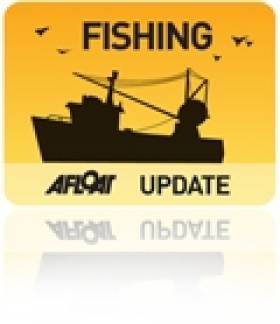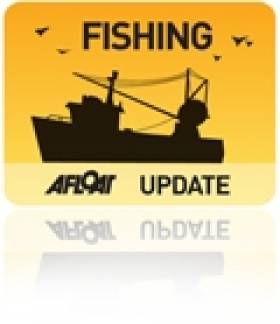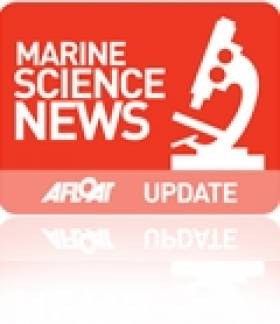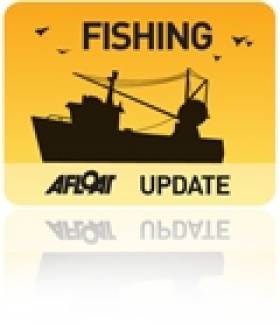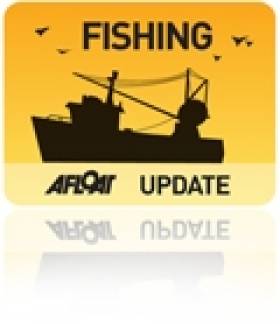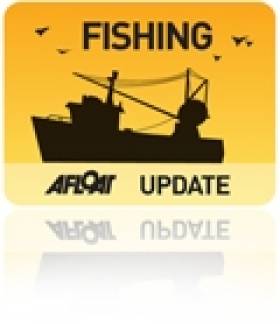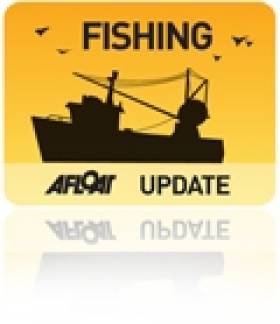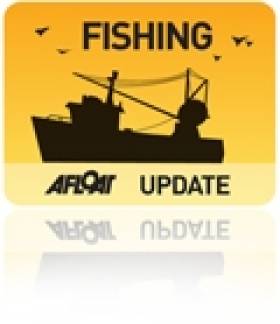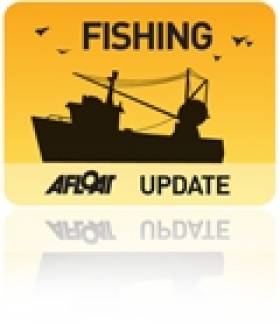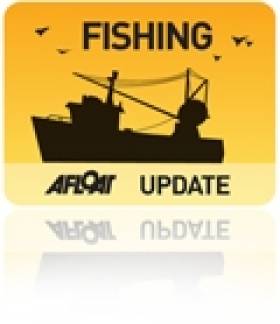Displaying items by tag: Seafood
#Seafood - Lough Neagh eels may no longer be protected by Brussels regional designation rules if a proposed free trade deal with North America goes through.
As the Belfast Telegraph reports, the lough's eels are among a number of foodstuffs in Northern Ireland that come under EU Protected Geographical Indication, which means that only products produced in a particular area – like Cornish pasties or parmesan cheese – can be named and marketed as such.
But German agriculture minister Christian Schmidt has said that such protections, which are not recognised in the United States, may have to be abandoned "if we want to take advantage of the opportunities of free trade with the huge American market".
The Belfast Telegraph has more on the story HERE.
Minister Welcomes Outcome Of Ireland-Russia Talks On Meat, Dairy & Seafood Sectors
#Seafood - Marine Minister Simon Coveney welcomed the outcome of yesterday’s (18 December) high-level bilateral meeting in Moscow between his department and the Russian authorities on agri-food issues, including seafood.
The meeting was held at the request of the Department of Agriculture, Food and the Marine and built on the recent meeting in Dublin between the minister and the Ambassador of the Russian Federation to Ireland.
“Russia is an important market for Irish agri-food products but unfortunately this trade has been restricted by issues arising from the Russian ban on EU food and drink products as well as their audit of Ireland’s exporting plants earlier this year," said Minister Coveney.
"Through the Irish Embassy in Moscow we have been actively pursuing a bilateral meeting for some time to complement the intense engagement which we have had with Russian counterparts over the last few months. I am pleased to hear that yesterday’s meeting continued the constructive dialogue between both sides and progressed a number of key issues.”
The meeting focused on the department's response to the interim report on the audit findings received from the Russian authorities earlier this year.
The comprehensive response, incorporating the corrective actions for each establishment visited, has been submitted in full and the Russian side confirmed at the meeting that the final report will issue before the end of this month.
Commenting on this, the minister said that “confirmation that the final report will arrive before the end of the month was very welcome and gives us a solid basis for resolving these issues.
"We will prioritise our response to the final report with a view to having the temporary restrictions lifted on the affected dairy, beef and seafood plants as soon as possible.”
The meeting concluded with a proposal by both sides to meet again in January.
“I am under no illusion that considerable work remains to be done if we are to regain some of the market share prior to the events of this year," added Minister Coveney. "Equally it must be remembered that some of this market restriction is common to all EU Member States and stems from political issues unrelated to the agri-food sector.
"Nonetheless I am encouraged by the positive spirit in which this bilateral discussions took place and most importantly that there is a clear roadmap for future engagement and that another meeting is confirmed for January.
"In parallel to these discussions, I will be continuing my engagement with the European Commission and my counterparts from other EU states to ensure that the right market support measures are being deployed to help producers and processors in Ireland to help overcome the effects of the Russia ban."
Ireland’s agri-food trade to Russia in 2013 was worth €235m before EU sanctions were put in place.
Marine Institute Announces Boost For Seafood Research
#MarineScience - The Marine Institute has secured €800,000 research funding from the Department of Agriculture, Food and the Marine to carry out three significant research projects that address the needs of the aquaculture and seafood industry in the areas of shellfish health and seafood safety.
The funding was announced yesterday (Thursday 1 December) by Marine Minister Simon Coveney as part of the FIRM (Food Institutional Research Measure) competitive research funding programme, and follows the news earlier this month that Ireland's marine researchers won €5.5 million in the latest EU Horizon 2020 funding round in the areas of 'blue growth' and sustainability.
The collaborative projects, which have a total value of €1.2 million, include research partners at NUI Galway, University College Cork and University College Dublin.
The projects will address current challenges in aquaculture and aim to further enhance the health status and food safety standards of farmed Irish shellfish; and ensure compliance with food/feedstuff standards for seaweed.
Dr Peter Heffernan, chief executive of the Marine Institute, welcomed the announcement, saying these projects "will build on the work we are doing in the areas of fish health and seafood safety, together with our research partners.
"We have a strong seafood safety regime in Ireland and these research awards will help to increase our knowledge and further enhance the quality and safety of Irish seafood products."
Dr Heffernan also acknowledged two further research award recipients in NUI Galway and Dublin City University who will focus their research on sustainable aquaculture production systems and mining marine material for novel functional ingredients.
Early in the new year the Marine Institute will seek to fill the three research posts arising from these projects.
Clogherhead Trawlerman Is Named Young Fishmonger For 2015
#Seafood - A former trawlerman has been named as Bord Iascaigh Mhara's (BIM) Young Fishmonger for 2015, as The Irish Times reports.
Gerard Collier of Fisherman's Catch in Clogherhead was selected from a shortlist of five for the accolade, which recognises excellence in product knowledge, customer service and technical skill.
As previously reported on Afloat.ie, the winner receives a cash prize of €1,000 as well as a study trip to France, while he and his fellow finalists will get a set of professional knives and a place on BIM's retail development workshops, on top of their masterclass with from Kinsale-based chef Martin Shanahan.
"All of our finalists were exceptional throughout every stage of the competition and they should be very proud of their achievements," said Donal Buckley, BIM's business development and innovation director.
"Congratulations to our worthy winner Gerard Collier and his colleagues at Fisherman’s Catch, I hope this experience and the competition prize fund allows you to further develop what is a very successful family business."
Meanwhile, last year's winner James Kirwan of East Coast Seafood in Naas, Co Kildare, spoke of how the prize money allowed him to install a new kitchen in the shop to produce a range of fish soups, burgers and pies, while the study trip "was a real learning curve for me in terms of understanding customers' preferences."
The Irish Times has more on the story HERE.
Young Fishmongers Sharpen Their Skills For Second Annual BIM Contest
#Seafood - The five finalists in the Bord Iascaigh Mhara (BIM) Young Fishmonger 2015 competition had their practical skills put to the test today (12 November) ahead of the awards ceremony later this month.
BIM's Seafood Development Centre in Clonakilty, West Cork hosted the five men who made the shortlist as they were charged with filleting and preparing a range of fish and shellfish under strict time constraints.
The five finalists – Gerard Collier of Fisherman’s Catch in Clogherhead, Co Louth; Stevie Connolly of Connolly’s Fish Company in Rathmines, South Dublin; Mateusz Kowalik of Dorans on the Pier in Howth, Norh Dublin; Gary Quinn of Stephens Fish Market in Mullingar, Co Westmeath; and Neil Turner of Cavistons Food Emporium in Glasthule, South Dublin – have already been extensively judged in the competition.
This involved in-depth visits to their respective shops to assess their knowledge of seafood, their understanding of quality issues, skills, techniques and customer service.
Now in its second year, the BIM Young Fishmonger competition aims to recognise and reward young fishmongers and, in doing so, raise the bar across the sector in terms of product knowledge and skills.
"We are very proud of this initiative, it is a programme that directly recognises the high level of expertise and knowledge amongst young fishmongers around the country," said Donal Buckley, BIM’s business development and innovation director.
"It also promotes the valuable service a fishmonger provides to customers in terms of preparing and buying seafood and I hope this competition helps to encourage consumers to seek out their local fishmonger and support local business. Best of luck to all our finalists."
As part of their prize, the five finalists will receive a master class in seafood cookery from renowned TV chef and owner of Fishy Fishy restaurant in Kinsale, Martin Shanahan.
Finalists will also receive a specially designed trophy, a place on BIM’s retail development workshops, a set of professional knives and a cheque for €500. The overall winner will receive a study trip to France and a cheque for €1,000.
The winner of the Young Fishmonger 2015 competition will be announced at the Radisson St Helen’s Hotel in Stillorgan, South Dublin on 24 November.
Coveney Welcomes Record Irish Presence At Chinese Seafood Expo
#Seafood - Following a meeting today (5 November) with Chinese Vice Minister Niu Dun, who has responsibility for fisheries, Marine Minister Simon Coveney opened the largest ever Irish pavilion at the China Seafood & Fisheries Expo, which takes place in Qingdao this week.
Speaking at the event, Minister Coveney said: “Ireland has some of the finest seafood in the world, with a superior offering that is sustainably harvested from the pure, clean waters of the Atlantic Ocean.
"Business development and trade show events such as these are invaluable in building awareness of our high quality produce to an influential, targeted trade audience.
"China continues to be a growing market for Irish seafood and with exports increasing by over 300% since 2011 to reach €18 million in 2013. This strong trend in Irish exports to the region is continuing in 2014 with sales for the first 6 months up 56% compared to the same period last year.”
Organised by Bord Bia, Ireland’s stand will include representatives from a record 11 Irish seafood companies between today and Friday 7 November at the largest trade show in China, with more than 25,000 visitors expected from over 100 countries.
In 2013, China's seafood trade surpassed €20 billion in value, cementing its position as the world's leading seafood trading country. Growing incomes and increased urbanisation have helped fuel a massive growth in demand for imported seafood.
China currently accounts for one quarter of the world’s seafood consumption, and the United Nation’s FAO projects that China will need an extra 16 million tonnes of seafood by 2020 to meet growing demand.
Minister Coveney added: “The strong Irish representation from both the pelagic and shellfish sectors in Qingdao today demonstrates the commitment of both industry and government to deepen ties and strengthen relationships with our Chinese customers.”
Traditionally, the Chinese market has been important for the Irish seafood industry predominantly for the sale of pelagic species such as boarfish, which was launched in China this year after a successful presentation at the 2013 expo.
However, in the last three years, significant effort has been invested by Irish processors and Bord Bia to identify and develop opportunities for premium shellfish in this growing market for seafood, notably for shellfish such as live and processed brown crab, langoustines, scallops and razor fish.
Bord Bia chief executive Aidan Cotter said: “The strong and sustained growth in exports in recent years demonstrates the continued success of Ireland’s leading shellfish processors in penetrating this valuable market. Exports of shellfish to China, for example, increased in value by over 200% between 2012 and 2013, while exports to Hong Kong increased by 117% during the same period.
"Bord Bia has ambitious plans to further grow the share of Irish seafood into China and has a number of programmes in place to assist Irish seafood processors in identifying, profiling and targeting new customers that are willing to pay a premium for quality seafood from Ireland.”
Through its trade development programme, Bord Bia says it has been very successful in encouraging high-end retail and foodservice Chinese customers to visit Ireland to meet with Irish seafood processors on a one-to-one basis.
These itineraries have been described as very effective in generating new business for the sector, providing Irish companies with an excellent opportunity to showcase their processing facilities and also allowing the customers to see first hand the world-class environment in which Irish seafood is produced. These visits can provide a guarantee to Chinese customers on traceability, sustainability and food safety, all key issues of growing concern to the Chinese consumer.
“Irish seafood has enjoyed ongoing and increasing market access to China," said Dr Susan Steel, chair of the Sea-Fisheries Protection Authority. "International trade in food is based upon a reciprocated trust in food safety systems. The Sea-Fisheries Protection Authority, as regulator, verifies the safety and sustainability of Irish seafood and we welcome this Chinese confidence in the robustness of the assurance systems we implement."
During the last three years, Bord Bia has welcomed more than 25 Asian customers to Ireland on customised itineraries. Many of these visits have delivered new business for Irish seafood processors, and in March 2015, as part of its Marketplace International event, Bord Bia will host an additional 17 Asian customers on a visit to Ireland.
The buyers will meet with Ireland’s leading seafood processors, and Bord Bia has set a target of securing €7 million worth of new business for the seafood sector arising from this event.
In September 2013, over €4 million worth of new business was secured with a range of Asian seafood customers who travelled to Ireland to attend Bord Bia’s Global Sustainability Conference.
Going into 2015, to build on the momentum and further increase exports of premium Irish seafood to China, Bord Bia will concentrate its promotional efforts on increasing awareness of new species from Ireland such as brown crab and Irish prawns.
Targeting premium chefs, media and key opinion-formers, Bord Bia will co-ordinate a series of cookery demonstrations in Beijing and Shanghai, focusing on introducing recipes for these species that are new to the Chinese market.
The campaign will assist the Irish processing sector to sell in their ranges to distributors servicing the premium restaurants and hotels in these two key locations. In addition, Chinese consumers will be educated and informed through a comprehensive programme of in-store tastings with a number of supermarket retail chains.
#seafood – Following months of intense lobbying and negotiation, Minister Coveney today secured €148 million from this fund for the period 2014 to 2020 for the development of the Irish seafood industry and the coastal communities that depend upon it. Welcoming this announcement the Minister said 'This funding is more than double the amount that was available to Ireland during the last Common Fisheries Policy (CFP) and will ensure a strong fishing industry in Ireland that can grow expand to meet its potential up to 2020."
In announcing the EU funding, Minister Coveney said "The new CFP is a major overhaul of the way which fishing is carried out in EU waters, the purpose of which is to provide a framework for the long term sustainability of fish stocks and the whole industry. The fund will provide support for our fishing fleet to meet the challenges of the new discards ban; it will support the development of the seafood processing sector, a sustainable aquaculture industry and the communities that depend on a vibrant seafood industry."
The Minister went on to say that "I am satisfied the €148 million which I was able to negotiate for Ireland from the new fund will help our seafood industry to develop and maintain long term sustainability and economic strength. This is more than double the amount of funding that was available to Ireland in the last period from 2007 to 2013 and is, I believe, the level of the investment needed to meet the challenges and opportunities facing the Irish seafood industry."
Ireland must now prepare a programme setting out the arrangements for spending the fund and submit this to the Commission by 20 October 2014. The Department has been working on the new Operational Programme since 2013 and has engaged with stakeholders on a number of occasions to date. Further public consultation and strategic environmental assessment will take place over the summer 2014. The Minister added "We have already being consulting stakeholders on the framework for the new programme. Now that we know the amount of funds we have available we can finalise these consultations and put in place an ambitious programme of support that delivers on the priorities of the fishing industry and other stakeholders."
Under the new CFP, which was negotiated to completion under the Irish Presidency of the EU in 2013, a European Maritime and Fisheries Fund has now been established to support the delivery of the new policy.
#Seafood - Just days after his resignation as CEO of Bord Iascaigh Mhara (BIM), Jason Whooley has been announced as the chief executive of Bio-marine Ingredients Ireland, as OceanFM reports.
The new body, a joint venture between the Killybegs Fishermen’s Organisation and Norwegian firm Biomarine Science Technology, is behind the "game-changer" €35 million project in the Donegal fishery harbour that's expected to create 50 construction jobs and a further 70 direct and indirect positions once operational.
As previously reported on Afloat.ie, the new scheme - promoted by the development of the new boarfish fishery - is set to be the largest marine food ingredients plants in the world when it enters its first full year of production in 2017.
#Seafood - Marine Marine Simon Coveney has announced an award of €2.4 million in grant aid to 20 seafood processing companies under the 2014 Seafood Processing Business Investment Scheme.
The scheme is projected to deliver 157 jobs and €45 million in additional sales by 2016.
Taken in conjunction with private sector investment, the total investment will be almost €8 million in 2014.
The grants are co-funded by the Department of Agriculture, Food and the Marine and the European Fisheries Fund.
“Our seafood industry has the potential to achieve sales of €1 billion per annum by 2017 and to deliver 1,200 additional jobs in that period," said Minister Coveney, who added that the seafood processing sector "is a key growth area in our seafood industry and can make a major contribution to those overall seafood industry growth targets."
The minister also said the investment "will help to build scale, drive innovation and develop value added products to meet the considerable demand on our key international markets. It will enable these companies to invest in the required technology and resources to make this happen.
"I look forward to seeing the positive effect this investment has on the industry, both in terms of employment and sales, over the next three years.”
The 20 companies receiving grant aid are from eight coastal counties across the country: four in Co Cork (Castletownbere Fishermen's Co-Op; Good Fish Processing; Keohane Seafood; Ballycotton Seafoods), three in Co Galway (Cill Chiarain Eisc Teoranta; Iasc Mara Teoranta; Galway Bay Seafoods), two in Co Mayo (Connemara Seafoods Frozen; WM Carr & Sons), four in Co Donegal (Proseail An Clochan Liath Teo; Charles Vial; Earagail Eisc Teo; Arctic Fish), two in Dublin (Rockabill Shellfish; Dunns Seafare), three in Co Wexford (Atlantis Seafoods; Sofrimar; Kilmore Seafoods) and one each in Co Louth (Seafood Processors trading as Morgans) and Co Waterford (Iasc Sliogagh Dunlarbhain Dungarvan).
The Seafood Processing Business Investment Scheme is implemented as part of the State's Seafood Development Programme. Grant aid is at a maximum rate of 20% for primary processing and 30% for secondary processing projects and is co-funded on a 50/50 basis by the Department of Agriculture, Food and the Marine and the European Fisheries Fund.
The scheme is implemented by Bord Iascaigh Mhara (BIM) and Údarás na Gaeltachta, with Enterprise Ireland assisting in commercial evaluation of proposals.
Successful projects are selected for grant aid by a selection board comprising the Department of Agriculture Food and the Marine, BIM, Údarás na Gaeltachta, Enterprise Ireland, the Marine Institute, the South and East Regional Assembly and the BMW Regional Assembly.
Eligible companies are seafood processing SMEs with premises approved by the SFPA. Eligible costs may include the purchase of new machinery and equipment and the construction, extension or modernisation of seafood processing enterprises.
#Seafood - Marine Minister Simon Coveney has welcomed plans by the Killybegs Fishermen’s’ Organisation (KFO) and a Norwegian partner to build the largest marine food ingredients plant in the world in Killybegs, Co Donegal.
The plant, due to become fully operational by 1 January 2017, will produce valuable high-end marine protein for human consumption.
“This facility will become a ‘game-changer’ in the seafood sector," said the minister in his opening address at the BIM National Seafood Conference at Dublin's Aviva Stadium yesterday 2 April.
"It will position Killybegs and Ireland as a global leader in supply and research around new products and benefits from protein, oils and calcium associated with the sea," he added.
"This new processing facility arises from the new boarfish fishery which was developed by Irish fishermen over the past few years. In 2012, the EU introduced quota shares for the stock and Ireland secured 70% share of the fishery and has a quota of 88,000 tonnes in 2014.
"I am delighted that the new food ingredients project will maximise the value of a significant part of this fishery and centre the associated economic activity and jobs in the heartland of Ireland’s fishing community."
Minister Coveney confirmed that while the plans are at an early stage, “discussions are underway to finalise the full funding of the project. I look forward to the successful conclusion of these negotiations and to a formal announcement of this project in Donegal.
"KFO chief executive Sean O’Donoghue has invited me to Donegal to announce specific details of the project on 9 May, which I’m very pleased to accept subject to successful conclusion of the ongoing discussions.”
The focus of the conference, hosted by Bord Iascaigh Mhara and attended by seafood business leaders, global industry thinkers and world-renowned fisheries experts, was ‘capturing Ireland’s share of the global seafood opportunity’.
Minister Coveney added: “We all need to challenge our thinking and inform ourselves of best international practice so that Ireland will be able to position itself to maximise its share of the global seafood opportunity.
"Ireland may currently be a small player in the context of world seafood, however, given the huge resources around our coast it is clear that we should have major ambitions for sustainable growth of our seafood sector. This conference will contribute to making these ambitions a reality and the Killybegs food ingredients projects shows what can be done.”


























